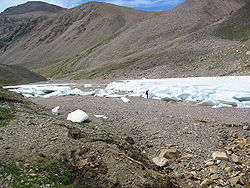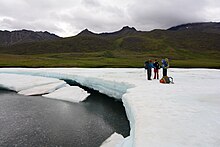
Aufeis (/ˈaʊfaɪs/ OW-fysse) (German for "ice on top") is a sheet-like mass of layered ice that forms from successive flows of ground or river water during freezing temperatures. This form of ice is also called overflow, icings, or the Russian term, naled (Russian: наледь). The term "Aufeis" was first used in 1859 by Alexander von Middendorff following his observations of the phenomenon in northern Siberia.
When thawed, aufeis leave footprints in the form of aufeis glades or, perhaps more accurately in tundra habitats, aufeis barrens, because of the near absence of vascular plants due to ice cover during much of the growing season.
Etymology
Aufeis literally translates from German to “on-ice”. In 1859 the Baltic German scientist and explorer Alexander von Middendorff used this term to describe his observations of the phenomenon in northern Siberia.
Formation

Aufeis accumulates during winter along stream and river valleys in arctic and subarctic environments. It forms by upwelling of river water behind ice dams, or by ground-water discharge. The latter mechanism prevails in high-gradient alpine streams as they freeze solid. Ground-water discharge is blocked by ice, perturbing the steady-state condition and causing a small incremental rise in the local water table until discharge occurs along the bank and over the top of the previously formed ice. Successive ice layers can grow and expand, attaining areas of ~25+ km and thicknesses of 6+ m. Aufeis typically melts out during summer and will often form in the same place year after year.
River aufeis form when the cross-sectional area of a stream channel becomes locally restricted as ice accumulates during winter. Such restrictions or “choke-points” result in bulk overflow and local increases in hydrostatic pressure, causing water to move upward through fissures onto the original ice layer. This overflowing water subsequently freezes to produce additional ice layers, thus explaining the origin of the term aufeis. This process, repeated through the long arctic winter, can generate large volumes of ice, with some aufeis in arctic Alaska—where they are also known as “icings”—attaining areas of 20+ km and localized thicknesses of 6+ m. The cumulative area of late-winter aufeis in the Sagavanirktok River drainage alone, for example, ranges from 102 to 103 km.
Impact

Sheets of aufeis may block stream channels and cause their flood plains to widen as spring floodwaters are forced to flow around the ice. Research on aufeis has to a large extent been motivated by the variety of engineering problems the ice sheets can cause (e.g. blocking drainages and causing flooding of roads).
Aufeis can present an extreme danger to recreational boaters even during summer months, who can find themselves trapped between walls of ice or pulled under aufeis by the current of the river. Breaking dams of aufeis can cause flash floods downriver.
When thawed, aufeis leave footprints in the form of “aufeis glades” or more accurately in tundra habitats, aufeis barrens, because of the near absence of vascular plants due to ice cover during much of the growing season. Aufeis barrens are distinctive landscape features of the arctic tundra and provide reliable indicators of aufeis locations".
City cooling
In late 2011, Mongolia planned to test the use and storage of artificial naleds as a way of cooling Ulan Bator in the hot Mongolian summer, and reducing the use of energy-intensive air conditioning.
Occurrence
River aufeis are common and widespread features of the arctic cryosphere, particularly in northern Alaska and Siberia. In eastern Siberia, where aufeis are known as naleds, 10,000 aufeis with a cumulative area of ~ 50,000 km containing 30 km of water have been documented in 2015.
Sheets of aufeis have been observed in Alaska, Arctic Canada, Russia, and Mongolia.
Analysis of satellite imagery from 2000 to 2015 has shown that the extent and duration of many Alaskan river icings has decreased due to climate change.
References
- ^ Hall, Dorothy K. (1980-01-01). "Mineral Precipitation in North Slope River Icings". Arctic. 33 (2). doi:10.14430/arctic2567. ISSN 1923-1245.
- ^ Middendorff, A. Th. von (1847). Reise in den äussersten Norden und Osten Sibiriens während der Jahre 1843 und 1844 mit Allerhöchster Genehmigung auf Veranstaltung der Kaiserlichen Akademie der Wissenschaften zu St. Petersburg ausgef. St. Petersburg: Buchdr. der K. Akademie der Wissenschaften : Zu haben bei Eggers. doi:10.5962/bhl.title.52029.
- Ashton, George D. 1986. River and lake ice engineering. Chelsea, Michigan, USA: Book Crafters, Inc.
- Leffingwell, Ernest de K. (1919). "The Canning River region, northern Alaska" (PDF). U.S. Geological Survey. p. 158.
- ^ Huryn, Alexander D.; Gooseff, Michael N.; Hendrickson, Patrick J.; Briggs, Martin A.; Tape, Ken D.; Terry, Neil C. (2020-10-13). "Aufeis fields as novel groundwater-dependent ecosystems in the arctic cryosphere". Limnology and Oceanography. 66 (3): 607–624. doi:10.1002/lno.11626. ISSN 0024-3590. S2CID 225139804.
- Hu, Xiaogang; Pollard, Wayne H. (September 1997). "The Hydrologic Analysis and Modeling of River Icing Growth, North Fork Pass, Yukon Territory, Canada". Permafrost and Periglacial Processes. 8 (3): 279–294. doi:10.1002/(SICI)1099-1530(199709)8:3<279::AID-PPP260>3.0.CO;2-7.
- ^ Alekseyev, V. R. (2015). "Cryogenesis and geodynamics of icing valleys". Geodynamics & Tectonophysics. 6 (2): 171–224. Bibcode:2015GeTec...6..171A. doi:10.5800/gt-2015-6-2-0177. ISSN 2078-502X.
- ^ Yoshikawa, Kenji; Hinzman, Larry D.; Kane, Douglas L. (December 2007). "Spring and aufeis (icing) hydrology in Brooks Range, Alaska: AUFEIS HYDROLOGY IN BROOKS RANGE". Journal of Geophysical Research: Biogeosciences. 112 (G4): n/a. doi:10.1029/2006JG000294.
- Clark, Ian D.; Lauriol, Bernard (May 1997). "Aufeis of the Firth River Basin, Northern Yukon, Canada: Insights into Permafrost Hydrogeology and Karst". Arctic and Alpine Research. 29 (2): 240. doi:10.2307/1552053. ISSN 0004-0851. JSTOR 1552053.
- Terry, Neil; Grunewald, Elliot; Briggs, Martin; Gooseff, Michael; Huryn, Alexander D.; Kass, M. Andy; Tape, Ken D.; Hendrickson, Patrick; Lane, John W. (March 2020). "Seasonal Subsurface Thaw Dynamics of an Aufeis Feature Inferred From Geophysical Methods". Journal of Geophysical Research: Earth Surface. 125 (3). Bibcode:2020JGRF..12505345T. doi:10.1029/2019JF005345. ISSN 2169-9003. S2CID 212853086.
- Shusun, L (May 1997). "Aufeis in the Ivishak River, Alaska, Mapped from Satellite Radar Interferometry". Remote Sensing of Environment. 60 (2): 131–139. Bibcode:1997RSEnv..60..131S. doi:10.1016/s0034-4257(96)00167-8. ISSN 0034-4257.
- ^ Harden, Deborah; Barnes, Peter; Reimnitz, Erk (1977). "Distribution and character of naleds in northeastern Alaska". Arctic. 30 (1): 28–40. doi:10.14430/arctic2681. Archived from the original on 2016-03-04. Retrieved 2015-10-27.
- ^ Kane, Douglas L. (1981). "Physical mechanics of aufeis growth". Canadian Journal of Civil Engineering. 8 (2): 186–195. doi:10.1139/l81-026.
- "Dangers of Aufeis on Alaskan Rivers". Alaska.org. Retrieved 21 November 2013.
- Huryn, Alexander D; Slavik, Karie A; Lowe, Rex L; Parker, Stephanie M; Anderson, Dennis S; Peterson, Bruce J (2005-08-01). "Landscape heterogeneity and the biodiversity of Arctic stream communities: a habitat template analysis". Canadian Journal of Fisheries and Aquatic Sciences. 62 (8): 1905–1919. doi:10.1139/f05-100. hdl:1912/232. ISSN 0706-652X.
- Watts, Jonathan (15 November 2011). "Mongolia bids to keep city cool with 'ice shield' experiment". The Guardian.
- Sokolov, B. L. (1991-08-01). "Hydrology of Rivers of the Cryolithic Zone in the U.S.S.R." Hydrology Research. 22 (4): 211–226. doi:10.2166/nh.1991.0015. ISSN 0029-1277.
- Veillette, J.J.; Thomas, R.D. (November 1979). "Icings and seepage in frozen glacio-fluvial deposits, District of Keewatin, NWT". Canadian Geotechnical Journal. 16 (4): 789–798. doi:10.1139/t79-084.
- Reedyk, Sharon; Woo, Ming-Ko; Prowse, Terry D. (1995). "Contribution of icing ablation to streamflow in a discontinuous permafrost area". Canadian Journal of Earth Sciences. 32 (1): 13–20. Bibcode:1995CaJES..32...13R. doi:10.1139/e95-002.
- Clark, Ian D.; Lauriol, Bernard (1997). "Aufeis of the Firth River Basin, Northern Yukon, Canada: Insights into Permafrost Hydrogeology and Karst". Arctic and Alpine Research. 29 (2): 240–252. doi:10.2307/1552053. JSTOR 1552053.
- Priesnitz, Kuno; Schunke, Ekkehard (2002). "The fluvial morphodynamics of two small permafrost drainage basins, northwestern Canada". Permafrost and Periglacial Processes. 13 (3): 207–217. doi:10.1002/ppp.424. S2CID 130985786.
- Alekseev, V.; Savko, N. (1975). The theory of naled processes. Nayka. pp. 1–205.
- Sokolov, B. L. (1978). Sanger, Frederick J. (ed.). Regime of Naleds. USSR Contribution, Permafrost: Second International Conference. National Academy of Sciences. pp. 408–411. ISBN 0-309-02746-2.
- Froehlich, Wojciech; Slupik, January (1982). French, H.M. (ed.). "River icings and fluvial activity in extreme continental climate: Khangai Mountains, Mongolia" (PDF). Proceedings, 4th Canadian Permafrost Conference: 203–211.
- Swanson-Hysell, Nicholas; Dander, Enkhbayar (2005). Eberhart, Marlene (ed.). A Sheet of Aufeis in the Kharkhiraa Mountains, Mongolian Altai (PDF).
{{cite book}}:|work=ignored (help) - Pavelsky, Tamlin M.; Zarnetske, Jay P. (2017-01-01). "Rapid decline in river icings detected in Arctic Alaska: Implications for a changing hydrologic cycle and river ecosystems". Geophysical Research Letters. 44 (7): 2016GL072397. Bibcode:2017GeoRL..44.3228P. doi:10.1002/2016GL072397. ISSN 1944-8007.
Further reading
- Wanty, Richard B.; Wang, Bronwen; Vohden, Jim; et al. (2007). Gough, Larry P.; Day, Warren C. (eds.). Aufeis Accumulations in Stream Bottoms in Arctic and Subarctic Environments as an Indicator of Geologic Structure (PDF). Recent U.S. Geological Survey Studies in the Tintina Gold Province, Alaska, United States, and Yukon, Canada — Results of a 5-Year Project (Report). Vol. Scientific Investigations Report 2007–5289–F. U.S. Department of the Interior and U.S. Geological Survey.
External links
 Media related to Aufeis at Wikimedia Commons
Media related to Aufeis at Wikimedia Commons
| Glaciers | |||||||
|---|---|---|---|---|---|---|---|
| Types | |||||||
| Anatomy | |||||||
| Processes | |||||||
| Measurements | |||||||
| Volcanic relations | |||||||
| Landforms |
| ||||||
| Related | |||||||